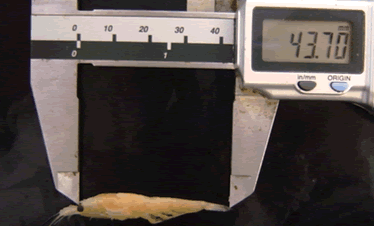
| Home > The Scientists > Matthew Brown | |||||||||||||||
It wasn’t until his third year at uni, however, that Matthew discovered a new passion. “I completed a unit on Antarctic Ecology and that made me realise that I really wanted to work on something in Antarctic marine science. So many people who have been to Antarctica have simply been amazed at its beauty, as it’s the most pristine place on Earth. I realised that I want to do my bit to help keep Antarctica this way.” Matthew is now enrolled in Honours at the Institute of Antarctic and Southern Ocean Studies (IASOS). He is investigating the reproduction of Antarctic krill (Euphausia superba) in the Indian Ocean Sector of the Southern Ocean. Krill are a key organism in the Antarctic ecosystem, both ecologically and economically.
To understand the reproduction of krill, Matthew firsts need to know three things: the length of their reproductive season, the number of spawning events in a season, and the number of eggs released by each krill. Krill from the Antarctic Peninsula have been observed to spawn multiple times in the summer season, from November to March, and each has the potential to release up to 20,000 eggs. “Compared to the Antarctic Peninsula krill, however,” says Matthew, “we don’t think those in the Indian Ocean Sector undergo multiple spawning. The sea ice extent and primary productivity here is less and the reproductive season is shorter, so fewer eggs are released.” To help with his research, Matthew will use 800 preserved female krill that were collected off the east of Antarctica, in the Indian Ocean Section, to determine whether they spawn multiple times and the number of eggs released. His project will contribute vital information towards the management of krill stocks as a commercial fishery.
So far this Honours project has been a great experience. “I work down at the Australian Antarctic Division in conjunction with other scientists,” Matthew says. “Learning and watching what they do is simply awesome and extremely beneficial, as I’m meeting future employers.” Matthew’s love for science, in particular his Honours project, is fulfilled by being continually challenged and learning and discovering so many new and important things that no one else knows. “Most of all it’s very satisfying to know that what I am doing is vitally important to other scientists and krill research, and also to the understanding of the Antarctic ecosystem as a whole. Plus my project, and science generally, provides great opportunities to travel. Next year I plan to do a PhD that involves working in Antarctica and also in Germany.” Find out more about Matthew's project Keywords: Krill, Phytoplankton, Southern Ocean Antarctic krill are a key organism in the Antarctic ecosystem both ecologically and economically. Krill play a central role in the relatively short and simple food chain in the Southern Ocean, primarily feeding on phytoplankton. In turn, higher organisms such as baleen whales, squid, fish, seals, seabirds and penguins prey them on. Furthermore, as the volume of commercially marketed krill products increases (for human consumption, fish feed and pharmaceutical industries), so will the fishing pressure. Removing large amounts of krill for commercial use will have an adverse affect on the population and the breeding success of the higher organisms, which rely on krill as a food source. Although the importance of krill in the Antarctic ecosystem has been recognised and they have been intensively studied in the past, the knowledge of the biology and ecology of krill is still far from complete. Furthermore, there has never been a major study on the reproduction of krill in the Indian Ocean Sector. Matthew’s Honours project will address some of these issues. He is investigating reproduction in krill from the Indian Sector of the Southern Ocean (80º - 150º E) to determine the different stages of sexual development of female krill, and to determine whether or not krill recycle their ovaries in one season and spawn multiple times. Krill are crustaceans, but, unlike most crustaceans, krill regress their size and external sexual characteristics during winter. Therefore, it is impossible to correctly stage their maturity and age from their external appearance. Consequently, a simple and internal method was developed by Cuzin-Roudy and Amsler (1991), which takes in account the general appearance, thelycum (opening of the females reproductive tract) development, ovarian morphology, and the developmental steps in the oocytes (eggs). Also, such a method is useful in predicting number of spawning events, timing, fecundity (number of eggs released) and other related energy requirements of Antarctic krill. Furthermore, this technique provides information on whether ovaries are producing new ‘eggs’ or the ovary is regressing in size after spawning. From the use of this technique, krill around the Antarctic Peninsula were discovered to undergo multiple spawning by recycling their ovaries during the summer season. Until now, no study has ever been done in the Indian Ocean Sector that has looked at the reproduction of Antarctic krill and whether or not they spawn multiple times. It is currently thought that because of generally low productivity and low sea ice extent (especially to the east of 115° E) in this region, krill do not recycle their ovaries and spawn multiple times. But is this true? The high biomass of krill in the Southern Ocean has a potential to be a large-scale fishing industry. Therefore, it is vitally important that krill are managed adequately so it remains a sustainable resource for the higher predators. However, management of krill cannot occur unless information on reproduction is known. Consequently, this experiment will go a long way in fishery management within the Indian Ocean, as it will determine information on egg production and how it is influenced by the environment. There are four key objectives of this project:
For more information and great ideas for classroom activities, visit:
|
|||||||||||||||


